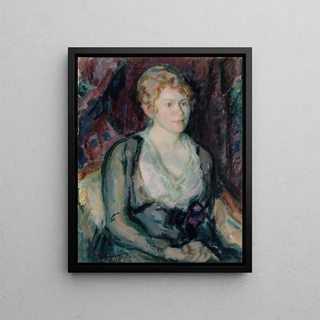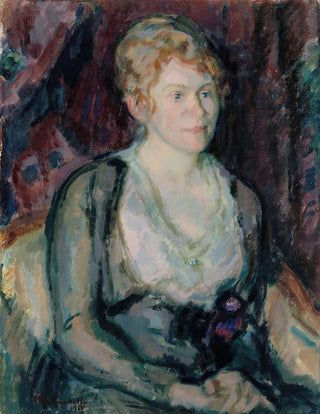Art print | Portrait of Mrs. Agda Viln - Magnus Enckell


View from behind

Frame (optional)
Art print Portrait of Mrs. Agda Viln - Magnus Enckell – Captivating introduction
The "Portrait of Mrs. Agda Viln" by Magnus Enckell is a work that transcends the simple framework of pictorial representation. This painting, which belongs to the symbolist movement, evokes an intimate and mysterious atmosphere while highlighting the beauty and complexity of its model. Enckell, a Finnish painter of the early 20th century, manages to capture not only the physical appearance of Mrs. Viln but also an emotional essence that resonates deeply with the viewer. Through this piece, he invites us to delve into a universe where the visible and invisible meet, where each brushstroke seems charged with a personal and universal story at once.
Style and uniqueness of the work
Magnus Enckell's style is distinguished by his bold use of colors and shapes, creating an atmosphere that is both dreamlike and introspective. In the "Portrait of Mrs. Agda Viln," delicate hues and subtle nuances blend to give life to a face imbued with mystery. The blurred contours and play of light accentuate the enigmatic character of the figure, making the painting almost alive. Enckell does not merely depict his model realistically; he explores the emotions and thoughts that inhabit her. This unique approach allows the work to transcend time and touch generations of viewers, who see themselves in this quest for authenticity and beauty.
The artist and his influence
Magnus Enckell, an emblematic figure of Finnish art, is often regarded as a precursor to modernism due to his ability to fuse tradition and innovation. His training with European masters nurtured a style that combines symbolist influences and elements of Art Nouveau. Enckell distanced himself from academic conventions to embrace a more personal and expressive vision of art. His work, marked by a keen sensitivity to psychological nuances, had a significant impact on his contemporaries and continues to inspire many artists today. By incorporating elements of everyday life and universal themes, he paved the way for a deeper exploration of human identity.

Matte finish

View from behind

Frame (optional)
Art print Portrait of Mrs. Agda Viln - Magnus Enckell – Captivating introduction
The "Portrait of Mrs. Agda Viln" by Magnus Enckell is a work that transcends the simple framework of pictorial representation. This painting, which belongs to the symbolist movement, evokes an intimate and mysterious atmosphere while highlighting the beauty and complexity of its model. Enckell, a Finnish painter of the early 20th century, manages to capture not only the physical appearance of Mrs. Viln but also an emotional essence that resonates deeply with the viewer. Through this piece, he invites us to delve into a universe where the visible and invisible meet, where each brushstroke seems charged with a personal and universal story at once.
Style and uniqueness of the work
Magnus Enckell's style is distinguished by his bold use of colors and shapes, creating an atmosphere that is both dreamlike and introspective. In the "Portrait of Mrs. Agda Viln," delicate hues and subtle nuances blend to give life to a face imbued with mystery. The blurred contours and play of light accentuate the enigmatic character of the figure, making the painting almost alive. Enckell does not merely depict his model realistically; he explores the emotions and thoughts that inhabit her. This unique approach allows the work to transcend time and touch generations of viewers, who see themselves in this quest for authenticity and beauty.
The artist and his influence
Magnus Enckell, an emblematic figure of Finnish art, is often regarded as a precursor to modernism due to his ability to fuse tradition and innovation. His training with European masters nurtured a style that combines symbolist influences and elements of Art Nouveau. Enckell distanced himself from academic conventions to embrace a more personal and expressive vision of art. His work, marked by a keen sensitivity to psychological nuances, had a significant impact on his contemporaries and continues to inspire many artists today. By incorporating elements of everyday life and universal themes, he paved the way for a deeper exploration of human identity.






